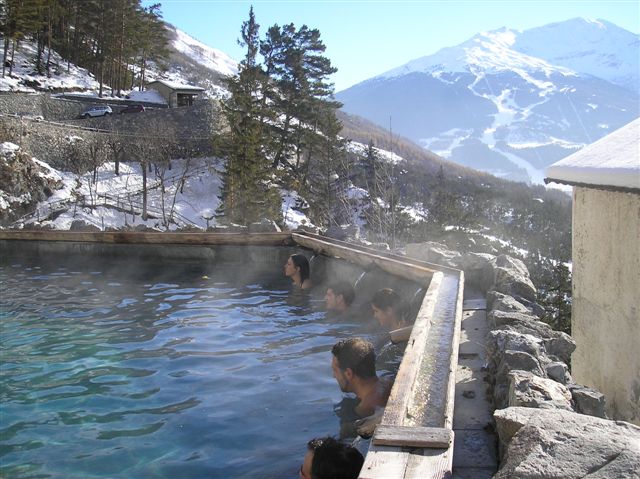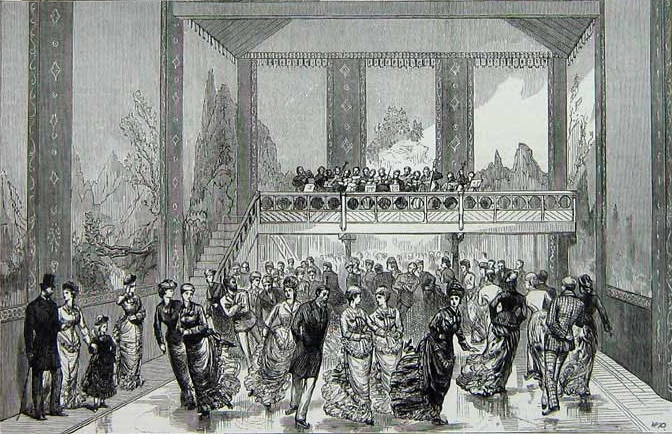|
Kurhaus Bergün
The Kurhaus Bergün was built as a grand hotel, opening in 1906. Located in the village of Bergün/Bravuogn in the Albula valley, south of Chur and north of St. Moritz, at an altitude of approximately above mean sea level, the Kurhaus is a well preserved/restored hotel of the Jugendstil (Art Nouveau) era. History The optimism of the early years After the construction of a road, following the river downstream to Filisur in 1855–58, the opening of the stunning Albula Railway in 1903 ushered in a second burst of development for Bergün, and an "initiative committee" started planning for the construction of a hotel in the village. Design was entrusted to the Zurich architect Jost-Franz Huwyler-Boller (1874–1930) who also worked on the Hotel Cresta Palace in Celerina at about the same time. The hotel opened to guests in the Spring of 1906, offering 120 beds in 85 rooms. It was hoped that Bergün's altitude and remote location would make it attractive as an acclimatisati ... [...More Info...] [...Related Items...] OR: [Wikipedia] [Google] [Baidu] |
Destination Spa
A destination spa or health resort is a resort centered on a spa, such as a mineral spa. Historically, many such spas were developed at the location of natural hot springs or mineral springs; in the era before modern biochemical knowledge and pharmacotherapy, "taking the waters" was often believed to have great medicinal powers. Even without such mystic powers, however, the stress relief and health education of spas also often has some degree of positive effect on health. Typically, over a seven-day stay, such facilities provide a comprehensive program that includes spa services, physical fitness activities, wellness education, healthy cuisine, and special interest programming. Some destination spas offer an all-inclusive program that includes facilitated fitness classes, healthy cuisine, educational classes and seminars, as well as similar to a beauty salon or a day spa. Guests reside and participate in the program at a destination spa instead of just visiting for a treatment o ... [...More Info...] [...Related Items...] OR: [Wikipedia] [Google] [Baidu] |
Hotels In Switzerland
A hotel is an establishment that provides paid lodging on a short-term basis. Facilities provided inside a hotel room may range from a modest-quality mattress in a small room to large suites with bigger, higher-quality beds, a dresser, a refrigerator and other kitchen facilities, upholstered chairs, a flat screen television, and en-suite bathrooms. Small, lower-priced hotels may offer only the most basic guest services and facilities. Larger, higher-priced hotels may provide additional guest facilities such as a swimming pool, business centre (with computers, printers, and other office equipment), childcare, conference and event facilities, tennis or basketball courts, gymnasium, restaurants, day spa, and social function services. Hotel rooms are usually numbered (or named in some smaller hotels and B&Bs) to allow guests to identify their room. Some boutique, high-end hotels have custom decorated rooms. Some hotels offer meals as part of a room and board arrangement. In Jap ... [...More Info...] [...Related Items...] OR: [Wikipedia] [Google] [Baidu] |
Viet Nam
Vietnam or Viet Nam ( vi, Việt Nam, ), officially the Socialist Republic of Vietnam,., group="n" is a country in Southeast Asia, at the eastern edge of mainland Southeast Asia, with an area of and population of 96 million, making it the world's sixteenth-most populous country. Vietnam borders China to the north, and Laos and Cambodia to the west. It shares maritime borders with Thailand through the Gulf of Thailand, and the Philippines, Indonesia, and Malaysia through the South China Sea. Its capital is Hanoi and its largest city is Ho Chi Minh City (commonly known as Saigon). Vietnam was inhabited by the Paleolithic age, with states established in the first millennium BC on the Red River Delta in modern-day northern Vietnam. The Han dynasty annexed Northern and Central Vietnam under Chinese rule from 111 BC, until the first dynasty emerged in 939. Successive monarchical dynasties absorbed Chinese influences through Confucianism and Buddhism, and expanded south ... [...More Info...] [...Related Items...] OR: [Wikipedia] [Google] [Baidu] |
Rattan
Rattan, also spelled ratan, is the name for roughly 600 species of Old World climbing palms belonging to subfamily Calamoideae. The greatest diversity of rattan palm species and genera are in the closed-canopy old-growth tropical forests of Southeast Asia, though they can also be found in other parts of tropical Asia and Africa. Most rattan palms are ecologically considered lianas due to their climbing habits, unlike other palm species. A few species also have tree-like or shrub-like habits. Around 20% of rattan palm species are economically important and are traditionally used in Southeast Asia in producing wickerwork furniture, baskets, canes, woven mats, cordage, and other handicrafts. Rattan canes are one of the world's most valuable non-timber forest products. Some species of rattan also have edible scaly fruit and heart of palm. Despite increasing attempts in the last 30 years at commercial cultivation, almost all rattan products still come from wild-harvested plants. ... [...More Info...] [...Related Items...] OR: [Wikipedia] [Google] [Baidu] |
Sissach
Sissach () is a municipality and the capital of the district of Sissach in the canton of Basel-Country, Switzerland. History Sissach is first mentioned around 1225-26 as ''Sissaho''. Geography Sissach has an area, of . Of this area, (28.2%) is used for agricultural purposes, while (25.0%) is developed. Of the rest of the land, (46.6%) is forested, (0.2%) is aqueous, and (0.1%) is otherwise undeveloped.Swiss Federal Statistical Office-Land Use Statistics 2009 data accessed 25 March 2010 Of the developed area, housing and buildings make up 12.4%, transportation infrastructure makes up 6.3%, and industrial buildings make up 2.8% . Power and water infrastructure as well as other special developed areas make up 1.6% of the area while parks, green be ... [...More Info...] [...Related Items...] OR: [Wikipedia] [Google] [Baidu] |
Giaco Schiesser
Giaco Schiesser (born 1953) is a Zurich-based theorist of cultural and media studies. He is a professor emeritus for cultural theory and media theory and for artistic research of Zurich University of the Arts, ZHdK (Switzerland). Biography Giaco Schiesser was born in Glarus (Switzerland). He studied philosophy, cultural studies and German literature studies at Free University of Berlin, Free University in Berlin (Germany). Afterwards he became an associate lecturer at Free University and assistant lecturer at the Institute for German Literature, University of Basle (Switzerland). From the mid-1980s to the mid-1990s he mainly worked as a publicist and a scientific editor: For ten years he was co-publisher of the scientific-political-cultural journal Widerspruch (journal), Widerspruch, for five years in charge of the department Science & Humanities of the weekly ''WOZ Die Wochenzeitung'', both published in Zurich. At the same time he was an associate researcher at the Hamburg-base ... [...More Info...] [...Related Items...] OR: [Wikipedia] [Google] [Baidu] |
Pontresina
Pontresina ( rm, Puntraschigna) is a municipality in the Maloja Region in the canton of Graubünden in Switzerland. History and name Pontresina was first mentioned in medieval Latin documents as ''ad Pontem Sarisinam'' in 1137 and ''de Ponte Sarraceno'' in 1237. The name consists of the Latin word for bridge, ''pons'' (accusative form: ''pontem''), and the male personal name ''Saracenus'', which was widely known in the Engadin valley. The earlier assumption that the name was connected with the Saracens has been discarded. Pontresina owes its importance to its location on the Bernina Pass and to tourism. In the Middle Ages, the place was more important than neighbouring St. Moritz. However, only a few buildings are reminiscent of this time, as Pontresina was hit by a major fire at the beginning of the 18th century. After the first inn was opened in 1850, tourism began to flourish. In the summer of 1885 there were already 2000 guests. In 1908, the resort received a further boost ... [...More Info...] [...Related Items...] OR: [Wikipedia] [Google] [Baidu] |
Graubunden
The Grisons () or Graubünden,Names include: *german: (Kanton) Graubünden ; * Romansh: ** rm, label=Sursilvan, (Cantun) Grischun ** rm, label=Vallader, (Chantun) Grischun ** rm, label= Puter, (Chantun) Grischun ** rm, label=Surmiran, (Cantun) Grischun ** rm, label=Sutsilvan, (Cantùn) Grischùn ** rm, label=Rumantsch Grischun, (Chantun) Grischun; * it, (Cantone dei) Grigioni ; *french: (Canton des) Grisons . See also other names. more formally the Canton of the Grisons or the Canton of Graubünden, is one of the twenty-six cantons of Switzerland. It has eleven regions, and its capital is Chur. The German name of the canton, , translates as the "Grey Leagues", referring to the canton's origin in three local alliances, the Three Leagues. The other native names also refer to the Grey League: in Sutsilvan, in the other forms of Romansh, and in Italian. ''"Rhaetia"'' is the Latin name for the area. The Alpine ibex is the canton's heraldic symbol. The largest and easternmost ... [...More Info...] [...Related Items...] OR: [Wikipedia] [Google] [Baidu] |
Ice Rink
An ice rink (or ice skating rink) is a frozen body of water and/or an artificial sheet of ice created using hardened chemicals where people can ice skate or play winter sports. Ice rinks are also used for exhibitions, contests and ice shows. The growth and increasing popularity of ice skating during the 1800s marked a rise in the deliberate construction of ice rinks in numerous areas of the world. The word "rink" is a word of Scottish origin meaning, "course" used to describe the ice surface used in the sport of curling, but was kept in use once the winter team sport of ice hockey became established. There are two types of ice rinks in prevalent use today: natural ice rinks, where freezing occurs from cold ambient temperatures, and artificial ice rinks (or mechanically frozen), where a coolant produces cold temperatures in the surface below the water, causing the water to freeze. There are also synthetic ice rinks where skating surfaces are made out of plastics. Besides rec ... [...More Info...] [...Related Items...] OR: [Wikipedia] [Google] [Baidu] |
Davos
, neighboring_municipalities= Arosa, Bergün/Bravuogn, Klosters-Serneus, Langwies, S-chanf, Susch , twintowns = } Davos (, ; or ; rm, ; archaic it, Tavate) is an Alpine resort town and a municipality in the Prättigau/Davos Region in the canton of Graubünden, Switzerland. It has a permanent population of (). Davos is located on the river Landwasser, in the Rhaetian Alps, between the Plessur and Albula Ranges. The municipality covers nearly the entire valley of the Landwasser, and the centre of population, economic activity, and administration is two adjacent villages: Davos Dorf () and Davos Platz (''Davos'' ''Place''), at above sea level. Gaining prominence in the 19th century as a mountain health resort, Davos is perhaps best known today for hosting the World Economic Forum—often referred to simply as "Davos"—an annual meeting of global political and corporate leaders. With a long history of winter sport, Davos also has one of Switzerland's larg ... [...More Info...] [...Related Items...] OR: [Wikipedia] [Google] [Baidu] |


_with_fruits_(7844049166).jpg)


